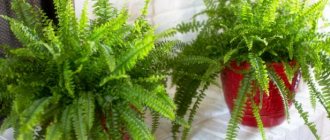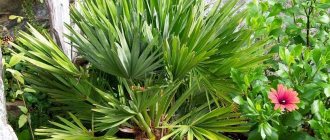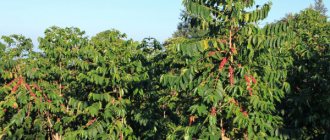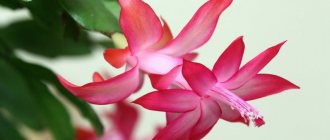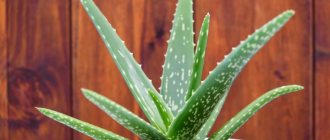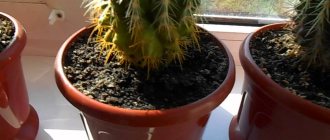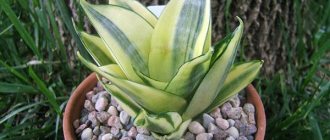A bright and attractive Dieffenbachia with luxurious striped leaves native to South America. The genus is named after the Austrian botanist Joseph Dieffenbach, who was head gardener at the Imperial Botanical Garden in Vienna in the 19th century.
All types of Dieffenbachia are evergreen plants from the Araceae family. In nature, they can grow up to 2 m, and can grow to the same size in an apartment. So you need a lot of space for this flower. The leaves are large, with spots and streaks, which gives them a special chic. But despite its beauty, Dieffenbachia can rarely be found in our apartments, because almost mystical powers are attributed to this plant. The chairman of the Moscow Flower Growers club, a collector of ornamental flowering plants, Tatyana Zhashkova, told us about the features of this plant
Types and varieties of Dieffenbachia
There are more than 60 species of Dieffenbachia in nature(1). But only a few of them are grown indoors.
Dieffenbachia seguine. In floriculture, it is better known under the old name Dieffenbachia maculata. This is one of the most popular species and the tallest - the plants reach a height of 2 m. The leaves are large, up to 50 cm long, with patterns of light specks.
There are many interesting varieties of this species.
- Green Magic - with deep green leaves with a cream vein in the center;
- Camille - it has white leaves with a green stripe along the edge;
- Compacta is a low-growing variety 50–65 cm high with light green leaves and dark green spots;
- Reflektor is a very bright variety with camouflage colored leaves: yellow and white spots are densely “scattered” on a dark green background;
- Rudolph Roehrs - with pistachio-colored leaves, a dark green stripe along the edge and a central vein of the same color, with white and green spots;
- Tropic Marianne - with cream-light green leaves with white veins and a thin dark green border;
- Tropic Sun - with light green leaves with a dark green border and central vein;
- Tropic Snow - with dark green leaves and numerous light stripes, streaks and spots;
- Tropical Tiki - with silvery leaves, on which numerous white spots are scattered, the border is dark green, and the central vein is light green.
Green Magic. Photo: YouTube
Camilla. Photo: YouTube
Reflector. Photo: YouTube
Tropical Tiki. Photo: YouTube
leopoldii . This species is native to Costa Rica. The plant is short, the trunk does not exceed 5 cm in height, but the leaves are long - up to 35 cm. They are dark green, with a white central vein. The petioles are short, about 15 cm, pale green with purple splashes.
Dieffenbachia oerstedii. Tall species up to 1.8 m high. Leaves up to 35 cm long, glossy, dark green, with a white vein in the center and sparse spots along it.
macrophylla . The species is native to Peru. The stem is up to 1 m high, the leaves are large, up to 60 cm long, rich green in color and have lighter veins. The juice has an unpleasant specific smell.
Dieffenbachia bausei. The plant is up to 90 cm high. The leaves are medium-sized, up to 30 cm long, oval, light green in color with a white marble pattern.
Dieffenbachia Estreda. Photo: YouTube
Dieffenbachia Bauze. Photo: YouTube
Dieffenbachia charming or Dieffenbachia pleasanta
Dieffenbachia (Amoena) or lovely is highly valued by gardeners due to its unpretentiousness and stability when grown in indoor floriculture. It is this species that is very easily able to tolerate shading, as well as low air humidity and high temperature conditions in rooms with central heating.
The height of Dieffenbachia pleasanta does not exceed one and a half meters. The plant has a fairly uniform coloration of dark green foliage. The leaves are oval, with white stripes along the veins. The average leaf length is about 50-60 cm.
Caring for Dieffenbachia at home
Dieffenbachia is quickly becoming a favorite because it looks very impressive and is also extremely unpretentious. But some features of agricultural technology still need to be taken into account.
Priming
Dieffenbachias come from tropical forests, and there is a lot of organic matter in the soils there. Therefore, the soil for them must be fertile. Purchased soil is suitable for decorative foliage plants.
But it’s better to cook it yourself. The best option is a mixture of leaf soil, humus, peat and sand in a ratio of 3:1:1:1 (2).
Temperature
These plants do not have a pronounced dormant period, so they need to be grown in a warm place throughout the year. The optimal temperature is 20 – 25 °C; in winter it should not fall below 17 °C. Dieffenbachia does not tolerate drafts and temperature changes.
Lighting
Dieffenbachias do not tolerate bright sun, much less direct sunlight - they need shade. Moreover, they can easily be tolerated even with minimal lighting - they can be grown in the back of the room. However, in winter it is useful to place it on the windowsill (3) - at this time the sun is inactive and harmless, and away from the window it becomes too dark.
Humidity
The plant loves abundant watering (in spring and summer once every 2-3 days, in autumn and winter - once every 4-5 days), but does not tolerate excess moisture, so the pot definitely needs drainage.
Fertilizers and fertilizers
It is useful to feed Dieffenbachia once every 2 weeks from March to September - this is when they actively grow. It is best to use a complex liquid fertilizer. But it is important that it does not contain a lot of nitrogen (2) - it causes plants to grow very quickly.
Trimming
As Dieffenbachia grows, it often sheds its lower leaves, exposing the trunk - this is their natural feature. However, the plants lose their decorative properties. In order for the bushes to be lush, they need to cut off the tops once a year - then the dormant buds on the stems will wake up and new young shoots will appear.
History and name
An evergreen exotic plant belonging to the aroid family, has a 150-year history. This family includes not only 30 species of Dieffenbachia, but also philodendron, monstera, alocasia, anthurium and others. Where did Dieffenbachia come to us from? The plant’s homeland is North and South America, and therefore it is not surprising that the crop prefers a humid and warm climate.
You may be interested in: Hygrophila Schisandra: description, features, cultivation
The genus got its name in honor of Joseph Dieffenbach, the chief gardener of the imperial palace in Vienna. After the discovery of America, traders and travelers were fascinated by this plant and often took it to other continents, where it quickly gained popularity due to its unpretentiousness. In its homeland, the Dieffenbachia plant is considered an evergreen perennial shrub.
Reproduction of Dieffenbachia at home
Photo: YouTube
Dieffenbachias reproduce well vegetatively and there are 2 methods that give excellent results.
Apical cuttings. In this case, cut off the top of the plant, tear off the lower leaves, if any, and plant the cuttings in a mixture of sand and sphagnum moss in equal proportions (2).
Stem pieces. It is better to root them in a mixture of sand and soil, also in equal proportions (2). Each piece should have 2–3 internodes. The stem sections are laid horizontally on the ground and covered with film or glass.
Both propagation options give best results in summer and late December. Cutting cuttings and pieces of stems is best combined with pruning the plant.
Dangerous properties of the plant
The chemical composition of Dieffenbachia juice contains oxalic acid and calcium oxolate (calcium oxalate). These are toxic substances that, when they come into contact with the skin and mucous membranes, cause burns and allergic reactions with irritation and swelling. May cause anaphylactic shock. If it enters the oral cavity or stomach, there is a high probability of spasms and cramps. Particular caution is recommended when there are children and animals in the house. When handling any plant, be careful and use rubber gloves.
Dieffenbachia diseases
Photo: YouTube
Problems with Dieffenbachia usually occur due to improper care.
The stem rots. This often happens if the plant is overwatered or the room is cool - the temperature is below 17 °C.
At the initial stage, when only part of the shoot is affected, the diseased tissue can be cut out with a sharp knife and the wound can be sprinkled with crushed charcoal. If the stem is severely rotten, you need to cut off and root the healthy top, and throw away the rest.
Leaves become pale. This happens if the plant is in too bright a room or if direct sunlight falls on it.
Move the Dieffenbachia to a darker place and the color of the leaves will soon be restored.
Young leaves fall. There are three reasons for this problem:
- temperature too low;
- dry air;
- drafts.
Move Dieffenbachia to a warm place and spray more often.
The edges of the leaves dry out. This occurs due to lack of watering - Dieffenbachias do not like it when the soil dries out; it should always be moist. The second possible reason is cold air.
Threats to the comfortable growth of a flower
Dieffenbachia flowers do not require complex care. The most important thing is to ensure a comfortable temperature regime and a stable microclimate. Hypothermia and drafts risk negatively affecting the well-being of the plant.
Dieffenbachia is also sensitive to long periods of lack of moisture or excessive watering. It is necessary to know and maintain a balance. Therefore, you need to carefully study how to water a flower.
If the conditions of detention are violated, Dieffenbachia may get sick. Often in this case, the tips of the leaves dry out or yellow spots appear. This is a sure sign that the plant is not feeling well.
Often the flower is attacked by parasites. Therefore, it is important to observe suitable growing conditions, as well as carry out pest prevention.
Pests of Dieffenbachia
Dieffenbachia most often affects 2 types of pests.
Spider mite. The first signs are numerous small whitish dots on the leaves. With severe infection, the leaves begin to turn yellow and fall off, and cobwebs appear on the plant.
To destroy spider mites, you can use the drug Kleschevit (4).
Shield. It usually lives on stems and on the undersides of leaves. The insects are motionless and look like small brown tubercles. With severe damage, the growth of Dieffenbachia slows down greatly, its leaves begin to dry out and eventually the plant may die.
It is difficult to fight scale insects. The first step is to manually remove all insects using a cotton pad soaked in alcohol or vodka. And then carry out 2 - 3 treatments of the plant with Actellik (4).
Why can't Dieffenbachia be kept at home?
The juice of this plant is poisonous to people and animals. If it gets on the skin, it can cause serious burns. If the juice gets into the stomach, swelling of the larynx and tongue, blurred vision, interruptions in heart function, and anaphylactic shock may occur. Therefore, it is not recommended to keep diffebanchias in apartments where there are animals and small children.
In addition to the obvious harm from the poisonous juice, the reputation of Dieffenbachia is also spoiled by the superstitions associated with it. It is believed that in ancient times, the leaf of this plant could deprive a person of speech by sealing his mouth (which is completely understandable - the poisonous juice, causing swelling of the larynx and tongue, did not give the person the opportunity to speak).
But now there is a different opinion: Dieffenbachia is called “husband,” a symbol of celibacy. It is believed that this plant weakens male energy, which is why men cannot be in the same room with it. Therefore, it is not recommended for unmarried girls to have it. By weakening male energy, Dieffenbachia allegedly makes married couples infertile.
But, of course, this is nothing more than superstition.
Dieffenbachia - impact on humans
With proper care, Dieffenbachia does not cause harm, but benefit. It can be considered a kind of indicator of the energy situation: it helps not only to identify negativity, but also to neutralize it.
Just keep in mind that Dieffenbachia should share its energy only with those who care for it and cherish it. She gives greater preference to the fair sex, which is why it is better for a woman to work with this plant. The flower will improve your well-being and help fight cellulite and signs of aging.
In addition, the plant has a very good effect on a person who is doing business or building a career. It helps to make informed decisions, assimilate information, rationally manage capital and make the right use of business contacts.
Magical, insidious, poisonous, spectacular - so many epithets, and all about one plant. Signs about Dieffenbachia say that the plant is not suitable for everyone and can create a positive atmosphere in the house only with proper care. If you have concerns about this plant, it may be worth getting another green friend. After all, fear itself makes a person vulnerable to negativity.
Popular questions and answers
Agronomist-breeder Svetlana Mikhailova told us about growing Dieffenbachia and the problems that may arise
How to choose Dieffenbachia?
Always pay attention to the appearance of the plant - there should be no stains, mechanical damage or signs of pests on the leaves. Inspect the shoots - it is important that they are not rotten.
Does Dieffenbachia bloom?
Yes, it blooms, but at home this does not happen often. And the flowers of Dieffenbachia are inconspicuous - a small cob surrounded by a green blanket.
Why do Dieffenbachia leaves turn yellow?
If the old lower leaves turn yellow and fall off, this is normal; this is a natural feature of Dieffenbachia. However, if young leaves turn yellow, then most likely the room is cool or the plant is in a draft.
Description of the flower
Trending Pilaf with chicken and shrimp
In indoor conditions, some types of Dieffenbachia reach two meters in height. The root system is powerful and branched. At the top of the flower and at the base of the stem, growth points are visible for the development of new shoots. Fleshy, straight, thick green stems are formed from the shoot formation points. In some plant species, a leafy cap is formed at the top of the stem, while in others, opposite leaves grow along the entire stem.
The leaves are wide, large, pointed or rounded at the edges, covered with a unique pattern. They show lighter inclusions, stripes, spots, and veins of yellow, beige, light green, pink and white shades. The length of the leaves in some varieties reaches 60 centimeters, the width is 40 centimeters.
Depending on their shape, Dieffenbachias are divided into trees and shrubs.
The tree-like variety has a strong and thick trunk, no branches. The trunk becomes bare as the flower matures. An adult flower is similar to a palm tree.
The shrub variety of Dieffenbachia is low. It has branched stems and many leaves. Leaves form near the base of the trunk. The bushes are voluminous and dense.
The inflorescences of all species resemble cobs and are surrounded by a creamy-green petal. The fruits that emerge from the flowers are orange or red berries.
Sources
- Dieffenbachia // The Plant List (https://www.theplantlist.org/1.1/browse/A/Araceae/Dieffenbachia/)
- Visyashcheva L.V., Sokolova T.A. Industrial floriculture. Textbook for technical schools // M.: Agropromizdat, 1991 – 368 p.
- Dr. Hessayon D.G. All about indoor plants // M.: Kladez-Buks, 2002 – 256 p.
- State catalog of pesticides and agrochemicals approved for use on the territory of the Russian Federation as of July 6, 2022 // Ministry of Agriculture of the Russian Federation (https://mcx.gov.ru/ministry/departments/departament-rastenievodstva-mekhanizatsii-khimizatsii -i-zashchity-rasteniy/industry-information/info-gosudarstvennaya-usluga-po-gosudarstvennoy-registratsii-pestitsidov-i-agrokhimikatov/)
Camilla
Another popular variety of Dieffenbachia, which came to us from the tropical forests of South America. This species grows up to two meters in length. On a strong stem there are large, oblong leaves, which are white closer to the middle, with a green border along the edge. With age, white spots disappear from the leaves of Dieffenbachia macrophylla. Camilla develops quickly - a new leaf grows within a week. In a ventilated room, protected from drafts, a shaded corner will be the best place for this plant.
Signs and superstitions
Since ancient times, many superstitions and signs have been associated with Dieffenbachia:
- a single woman who keeps Dieffenbachia in her house will not marry;
- the young couple will not have children;
- men develop potency;
- financial difficulties may befall the family.
Our ancestors came up with such signs, but there is no scientific or other evidence for this. Therefore, it is wiser to treat the plant not as a destroyer of family happiness, but as a source of energy and oxygen .
Reproduction
To propagate Dieffenbachia, apical cuttings no more than 12 cm long are used. They must be cut only with a disinfected sharp knife and after pruning it is imperative to treat the cut areas with an antiseptic. To do this, use charcoal or activated carbon, crushed into powder.
Remove the lower leaves from the cutting to reduce moisture loss and dip it in rooting powder ("Kornevin") with the lower end, then place it in moistened soil. Place the pot with the cuttings in a warm place (+21 °C) and cover the top with a glass jar to create a greenhouse effect. Every day the plant should be ventilated, removing the jar for about half an hour. Rooting occurs after a month and a half.
How to feed
– we usually fertilize during the active growth phase and after the dormant phase. This is spring until the very end of summer. We use liquid mineral fertilizers that can be diluted in water for irrigation. In the summer we feed twice a week. But during the rest period - once a month. Use organic liquid fertilizers that contain nitrogen.
Dieffenbachia reproduces very well. When propagating, you can use stem or apical cuttings. In principle, the plant is resistant to pests, but if a number of growing conditions are violated, minor problems may arise. Due to violation of the watering regime, all kinds of rot of roots and stems can occur. Viral and fungal diseases. Pests include scale insects, mealybugs, spider mites, aphids and thrips. As a problem arises, we carry out preventive measures; if a disease or pest is detected, we use the appropriate medications.
When composing compositions from Dieffenbachia, we take into account its size and growth characteristics. Tall and large plants can be planted in groups in one pot, and used as a single plant. More compact forms can be planted at the foot of adult Dieffenbachias. Or place it next to the main plant. They can also be combined with decorative foliage and flowering indoor plants. It is worth paying attention to Dieffenbachia sublim, Dieffenbachia mix, Dieffenbachia mix, Dieffenbachia reflector, Dieffenbachia bush. Good luck to you.
Precautions and advice from gardeners
We mentioned that Dieffenbachia juice (the variety does not matter) is poisonous; it can cause severe allergic reactions - skin irritation, burns of mucous membranes. After each contact with flower juice, you should thoroughly wash your hands, and carry out all agricultural activities with gloves. If your family has very small children or pets, hold off on getting this plant.
A flower indoors can live for a very long time, but with age, the lower part of its stems becomes bare and becomes less attractive. Replace the flower with a fresh one in a timely manner, using apical cuttings.
The plant perfectly purifies indoor air from harmful impurities, such as xylene and toluene. This beautiful and not too demanding plant will fit perfectly into any interior and will delight all household members with its unusual appearance for a long time.
Source


